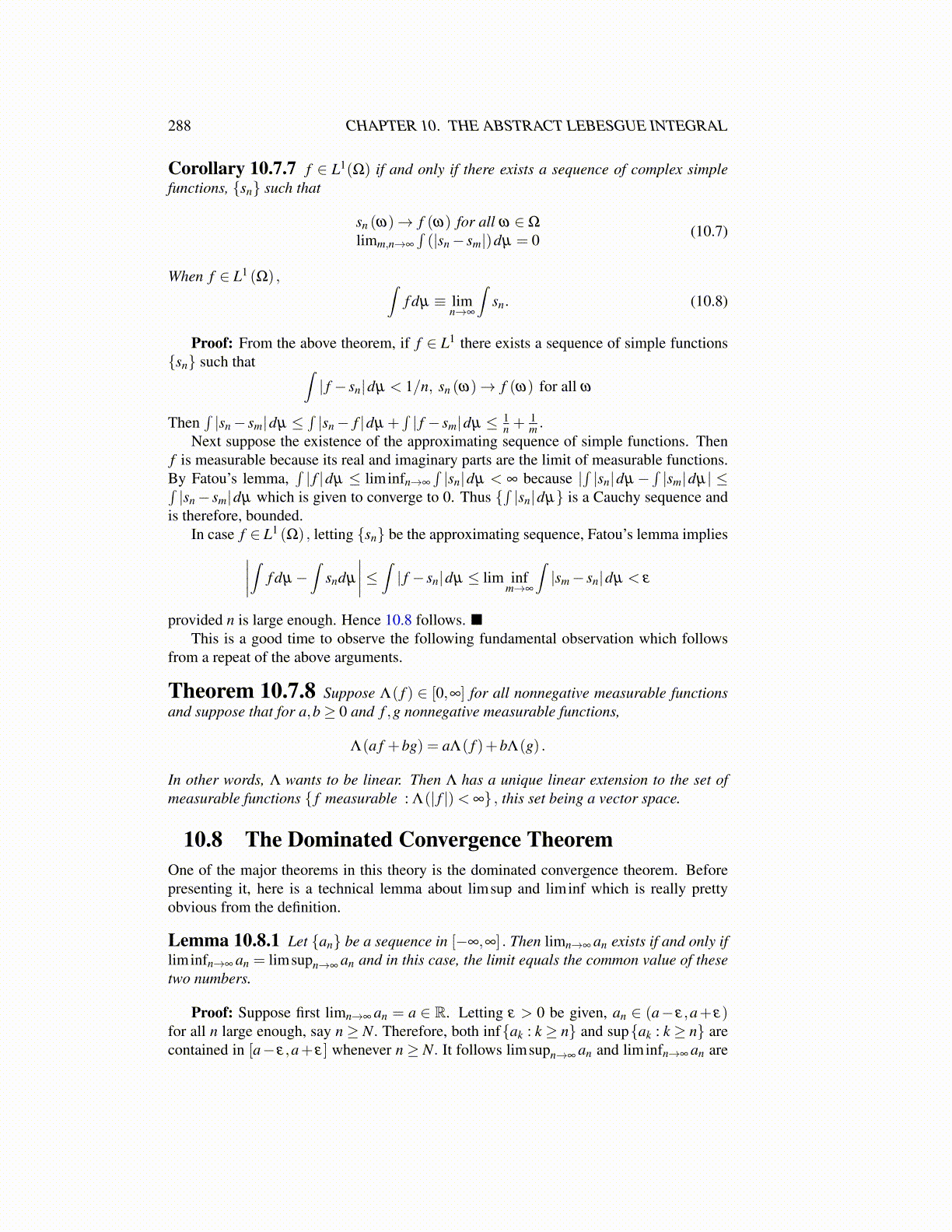
288 CHAPTER 10. THE ABSTRACT LEBESGUE INTEGRAL
Corollary 10.7.7 f ∈ L1(Ω) if and only if there exists a sequence of complex simplefunctions, {sn} such that
sn (ω)→ f (ω) for all ω ∈Ω
limm,n→∞
∫(|sn− sm|)dµ = 0 (10.7)
When f ∈ L1 (Ω) , ∫f dµ ≡ lim
n→∞
∫sn. (10.8)
Proof: From the above theorem, if f ∈ L1 there exists a sequence of simple functions{sn} such that ∫
| f − sn|dµ < 1/n, sn (ω)→ f (ω) for all ω
Then∫|sn− sm|dµ ≤
∫|sn− f |dµ +
∫| f − sm|dµ ≤ 1
n +1m .
Next suppose the existence of the approximating sequence of simple functions. Thenf is measurable because its real and imaginary parts are the limit of measurable functions.By Fatou’s lemma,
∫| f |dµ ≤ liminfn→∞
∫|sn|dµ < ∞ because |
∫|sn|dµ−
∫|sm|dµ| ≤∫
|sn− sm|dµ which is given to converge to 0. Thus {∫|sn|dµ} is a Cauchy sequence and
is therefore, bounded.In case f ∈ L1 (Ω) , letting {sn} be the approximating sequence, Fatou’s lemma implies∣∣∣∣∫ f dµ−
∫sndµ
∣∣∣∣≤ ∫ | f − sn|dµ ≤ lim infm→∞
∫|sm− sn|dµ < ε
provided n is large enough. Hence 10.8 follows. ■This is a good time to observe the following fundamental observation which follows
from a repeat of the above arguments.
Theorem 10.7.8 Suppose Λ( f ) ∈ [0,∞] for all nonnegative measurable functionsand suppose that for a,b≥ 0 and f ,g nonnegative measurable functions,
Λ(a f +bg) = aΛ( f )+bΛ(g) .
In other words, Λ wants to be linear. Then Λ has a unique linear extension to the set ofmeasurable functions { f measurable : Λ(| f |)< ∞} , this set being a vector space.
10.8 The Dominated Convergence TheoremOne of the major theorems in this theory is the dominated convergence theorem. Beforepresenting it, here is a technical lemma about limsup and liminf which is really prettyobvious from the definition.
Lemma 10.8.1 Let {an} be a sequence in [−∞,∞] . Then limn→∞ an exists if and only ifliminfn→∞ an = limsupn→∞ an and in this case, the limit equals the common value of thesetwo numbers.
Proof: Suppose first limn→∞ an = a ∈ R. Letting ε > 0 be given, an ∈ (a− ε,a+ ε)for all n large enough, say n ≥ N. Therefore, both inf{ak : k ≥ n} and sup{ak : k ≥ n} arecontained in [a− ε,a+ ε] whenever n ≥ N. It follows limsupn→∞ an and liminfn→∞ an are